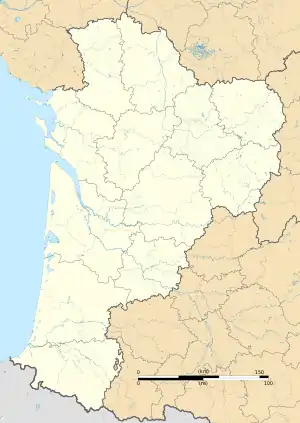Montagrier | |
|---|---|
.JPG.webp) A general view of Montagrier | |
.svg.png.webp) Coat of arms | |
Location of Montagrier | |
 Montagrier  Montagrier | |
| Coordinates: 45°16′17″N 0°28′39″E / 45.2714°N 0.4775°E | |
| Country | France |
| Region | Nouvelle-Aquitaine |
| Department | Dordogne |
| Arrondissement | Périgueux |
| Canton | Brantôme en Périgord |
| Government | |
| • Mayor (2020–2026) | Francis Lafaye[1] |
| Area 1 | 14.04 km2 (5.42 sq mi) |
| Population | 501 |
| • Density | 36/km2 (92/sq mi) |
| Time zone | UTC+01:00 (CET) |
| • Summer (DST) | UTC+02:00 (CEST) |
| INSEE/Postal code | 24286 /24350 |
| Elevation | 68–207 m (223–679 ft) (avg. 110 m or 360 ft) |
| 1 French Land Register data, which excludes lakes, ponds, glaciers > 1 km2 (0.386 sq mi or 247 acres) and river estuaries. | |
Montagrier (French pronunciation: [mɔ̃taɡʁije]) is a commune in the Dordogne department in Nouvelle-Aquitaine in southwestern France.
Population
| Year | Pop. | ±% p.a. |
|---|---|---|
| 1968 | 411 | — |
| 1975 | 389 | −0.78% |
| 1982 | 385 | −0.15% |
| 1990 | 397 | +0.38% |
| 1999 | 443 | +1.23% |
| 2009 | 504 | +1.30% |
| 2014 | 522 | +0.70% |
| 2020 | 503 | −0.62% |
| Source: INSEE[3] | ||
Sights
The Romanesque church was formerly a priory church. It contains a tenth-century inscription on a plaque, and the precincts now form a pleasant small park. Little remains of the walls which once surrounded the village. Unusually, for such a small place, Montagrier also has two chapels. Services are still held at Saint Sicaire, on the opposite end of the village from the church. There is also a tiny former chapel next to the auberge which is now used as an information centre. It is opposite the site of the castle (of which only the ruins of the stables remain). The chapel may have served the castle in the Middle Ages. During the Hundred Years War, the castle was in the possession of the Montagus, then resident in England.
See also
References
- ↑ "Répertoire national des élus: les maires". data.gouv.fr, Plateforme ouverte des données publiques françaises (in French). 2 December 2020.
- ↑ "Populations légales 2021". The National Institute of Statistics and Economic Studies. 28 December 2023.
- ↑ Population en historique depuis 1968, INSEE